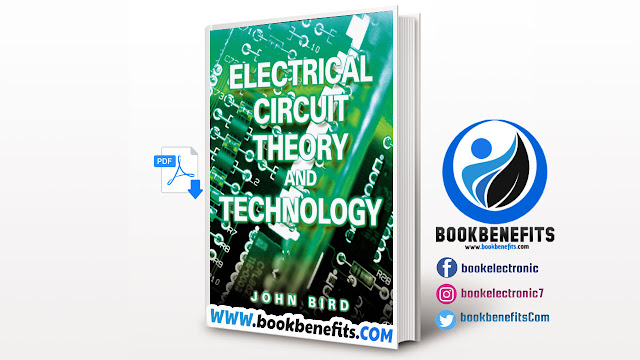Download Electrical Circuit Theory and Technology PDF
Electrical Circuit Theory and Technology PDF
Picture Of the Book:
Electrical Circuit Theory and Technology PDF
About Of the Book:
"Electrical Circuit Theory and Technology" by John Bird is a comprehensive textbook that covers the fundamental principles of electrical circuit theory and technology. The book covers both DC and AC circuits and includes a wide range of worked examples and problems to help readers understand the material. The book is divided into three main parts: DC circuit theory, AC circuit theory and advanced circuit theory.
The first part of the book covers topics such as circuit laws, circuit theorems, passive circuit elements, and operational amplifiers. The second part covers AC circuit theory, including complex numbers, phasors, AC circuit analysis and three-phase systems. The third part of the book covers advanced circuit theory, including frequency response, resonance, network theorems and two-port networks.
It is designed for students studying electrical and electronic engineering, as well as students of physics and technology. It is widely used as a textbook for undergraduate courses in electrical engineering and technology.
The book is considered a good resource for students and professionals alike, as it provides a clear and concise introduction to the fundamental principles of electrical circuit theory and technology.
‘Electrical Circuit Theory and Technology, revised second Edition’ provides coverage for a wide range of courses that contain electrical principles, circuit theory and technology in their syllabuses, from
Introductory to degree level. The chapter ‘Transients and Laplace transforms’, which had been removed from the second edition due to page restraints, has been included in this edition in response to popular demand.
The text is set out in four parts as follows:
PART 1, involving chapters 1 to 12, contains ‘Basic Electrical Engineering Principles’ which any student wishing to progress in electrical engineering would need to know. An introduction to electrical
circuits, resistance variation, chemical effects of electricity, series and parallel circuits, capacitors and capacitance, magnetic circuits, electromagnetism, electromagnetic induction, electrical measuring
instruments and measurements, semiconductor diodes and transistors are all included in this section.
PART 2, involving chapters 13 to 22, contains ‘Electrical Principles and Technology’ suitable for Advanced GNVQ, National Certificate, National Diploma and City and Guilds courses in electrical and electronic engineering. D.c. circuit theory, alternating voltages and currents, single-phase series and parallel circuits, d.c. transients, operational amplifiers, three-phase systems, transformers, d.c. machines and threephase induction motors are all included in this section.
PART 3, involving chapters 23 to 45, contains ‘Advanced Circuit
Theory and Technology’ suitable for Degree, Higher National Certificate/Diploma and City and Guilds courses in electrical and electronic/telecommunications engineering. The two earlier sections of the
book will provide a valuable reference/revision for students at this level.
Complex numbers and their application to series and parallel networks, power in a.c. circuits, a.c. bridges, series and parallel resonance and Q-factor, network analysis involving Kirchhoff’s laws, mesh and nodal analysis, the superposition theorem, Thevenin’s and Norton’s theorems, ´delta-star and star-delta transforms, maximum power transfer theorems and impedance matching, complex waveforms, harmonic analysis, magnetic materials, dielectrics and dielectric loss, field theory, attenuators,
filter networks, magnetically coupled circuits, transmission line theory and transients and Laplace transforms are all included in this section.
PART 4 provides a short, ‘General Reference’ for standard electrical quantities — their symbols and units, the Greek alphabet, common prefixes and resistor colour coding and ohmic values.
At the beginning of each of the 45 chapters learning objectives are listed.
At the end of each of the first three parts of the text is a handy reference of the main formulae used.
It is not possible to acquire a thorough understanding of electrical principles, circuit theory and technology without working through a large number of numerical problems. It is for this reason that ‘Electrical Circuit
Theory and Technology, Revised second Edition’ contains some 740 detailed worked problems, together with over 1100 further problems, all with answers in brackets immediately following each question. Over 1100 line diagrams further enhance the understanding of the theory.
Fourteen Assignments have been included, interspersed within the text every few chapters. For example, Assignment 1 tests understanding of chapters 1 to 4, Assignment 2 tests understanding of chapters 5 to 7, Assignment 3 tests understanding of chapters 8 to 12, and so on. These Assignments do not have answers given since it is envisaged that lecturers could set the Assignments for students to attempt as part of their course structure. Lecturers’ may obtain a complimentary set of solutions of the
Assignments in an Instructor’s Manual available from the publishers via the internet— see below.
‘Learning by Example’ is at the heart of ‘Electrical Circuit Theory and Technology, Revised second Edition’.
Contents Of The Book :
1 Units associated with basic electrical quantities
2 An introduction to electric circuits
3 Resistance variation
4 Chemical effects of electricity
5 Series and parallel networks
6 Capacitors and capacitance
7 Magnetic circuits
8 Electromagnetism
9 Electromagnetic inductions
10 Electrical measuring instruments and measurements
11 Semiconductor diodes
12 Transistors
13 D.c. circuit theory
14 Alternating voltages
and currents
15 Single-phase series
a.c. circuits
16 Single-phase parallel
a.c. circuits
17 D.c. transients
18 Operational
amplifiers
19 Three phase systems
20 Transformers
21 D.c. machines
22 Three-phase
induction motors
23 Revision of complex
numbers
24 Application of
complex numbers to
series a.c. circuits
25 Application of
complex numbers to
parallel a.c. networks
26 Power in a.c. circuits
27 A.c. bridges
28 Series resonance and
Q-factor
29 Parallel resonance
and Q-factor
30 Introduction to
network analysis
31 Mesh-current and
nodal analysis
32 The superposition
theorem
33 Thevenin’s and ´ Norton’s theorems
34 Delta-star and
star-delta
transformations
Read More...
Information Of the Book:
Title: Electrical Circuit Theory and Technology Download PDF
Size: 7 Mb
Pages: 1005
Year: 2007
Format: PDF
Language: English
Author: Dale Wheat
The download links have been moved to this site 👉www.electronic07.com 👈

